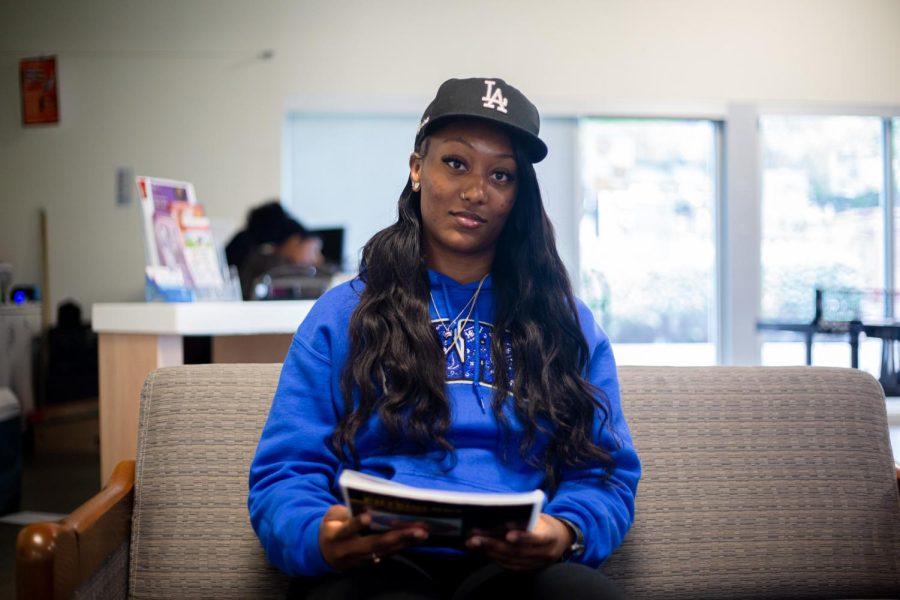The future of Black women in STEM
Alyssa Singleton holds a physiology book on Oct. 29, 2022, in Northridge, Calif.
November 24, 2022
Before deciding to attend CSUN, public health major Alyssa Singleton felt neglected by administrators at her high school. She shared that many educators, despite wanting the best for the students, did not know how to handle the issues that many of the students faced at home.
“I’m from L.A., and if you’re from the inner-city then you’re already directed towards the poorer schools and poor education. The high schools and the teachers are not encouraging you to go to college, and yes they want you to graduate, but college is not made the top choice,” Singleton said. “I feel like they should let students know that they do have options.”
Singleton even shared how a college advisor discouraged her from attending a university, citing that due to her grades the previous semester, no one would ever consider or even accept her.
“It made me feel like I wouldn’t make it in life. It made me feel like I was not meant for greatness,” Singleton said.
Now in her senior year at CSUN, Singleton’s experience personifies the struggle that many Black women endure when they try to branch out into spaces they are not represented in.
A study conducted by a pair of scholars, Abiola A. Farinde and Chance W. Lewis of the University of North Carolina, analyzed math and science test scores of Black women to learn how educators played a factor in the low rates of Black women in STEM. They found that Black girls outperformed their male counterparts in testing, a disparity when compared to other races where men outperform women in math and science, but they are not “further challenged academically” despite their high potential. According to the study, socioeconomic factors also contributed significantly to the underrepresentation of Black girls in science, technology, engineering and math. Living in underserved communities, many Black girls were found to have internalized their poor performances as individual issues.
“The teachers did their best to show they cared about us,” Singleton said. “It still never took away from what we had to experience at home or in our communities.”
Without the proper stability and encouragement to focus on their studies, many Black girls that want to study STEM are equipped with “poor academic preparation in STEM areas,” according to Farinde and Lewis.
This lack of preparation becomes the most damaging in standardized testing, where colleges look toward SAT and ACT test scores to decide who to designate spots to.
In the U.S., women make up nearly 47% of the workforce, according to an article released by the Pew Research Center. Still, they are underrepresented in STEM occupations compared to men, as women account for about 40% of physical scientists, 25% of computer scientists and only 15% of engineers and architects.
Blacks are largely underrepresented in STEM occupations, with only 9% of Black people holding paying positions in a STEM field, the Pew Research Center reported. For Black women, these gaps become more apparent. In the engineering and science spheres, Black female workers comprise only about 1.8% of the total workforce, according to data gathered by the National Science Foundation.
In the study by Farinde and Lewis, they noted that the lack of visibility of Black women and girls in STEM creates the idea that they just do not exist. This is reinforced through implicit biases and preconceived notions about Black women being largely uninterested in STEM subjects.
As a public health major in her fourth year, Daija Breland noted her positive exchanges with professors and other students at CSUN. Despite the support received during her undergrad, Breland shared her desire to see more people that looked like her succeeding in these fields.
“I’m normally the only Black girl in my class, so it’s kind of hard to relate to other students. Or if there are other Black students in the room, or Black women, they’re not in class,” Breland said.
In spite of the obstacles presented, the rates of women in STEM fields have increased. In 2019, the Society of Women Engineers found that the rate of women in STEM occupations rose from 42% to 44%. This increase was also seen among women of color in STEM fields, with Black women in particular earning more than half of the science and engineering degrees at higher education institutions.
Providing women, particularly women of color, with the opportunity to expand their interests in STEM can lead to positive development for many.
Third-year student and biology major Joy Tinsley attended an all-girls high school that prioritized teaching subjects like science and math to the girls in their community. According to Tinsley, her high school did not just teach these concepts but ensured that the girls understood how they were needed in these positions.
“My school was mostly about health, engineering and even art. They were really head-on with the idea that we need to take over these spaces especially as women and be in those fields,” Tinsley said.
Nurturing these attitudes regarding science, math and technology subjects can better equip Black women to enter the STEM field rather than leaving many scrambling for their futures.


